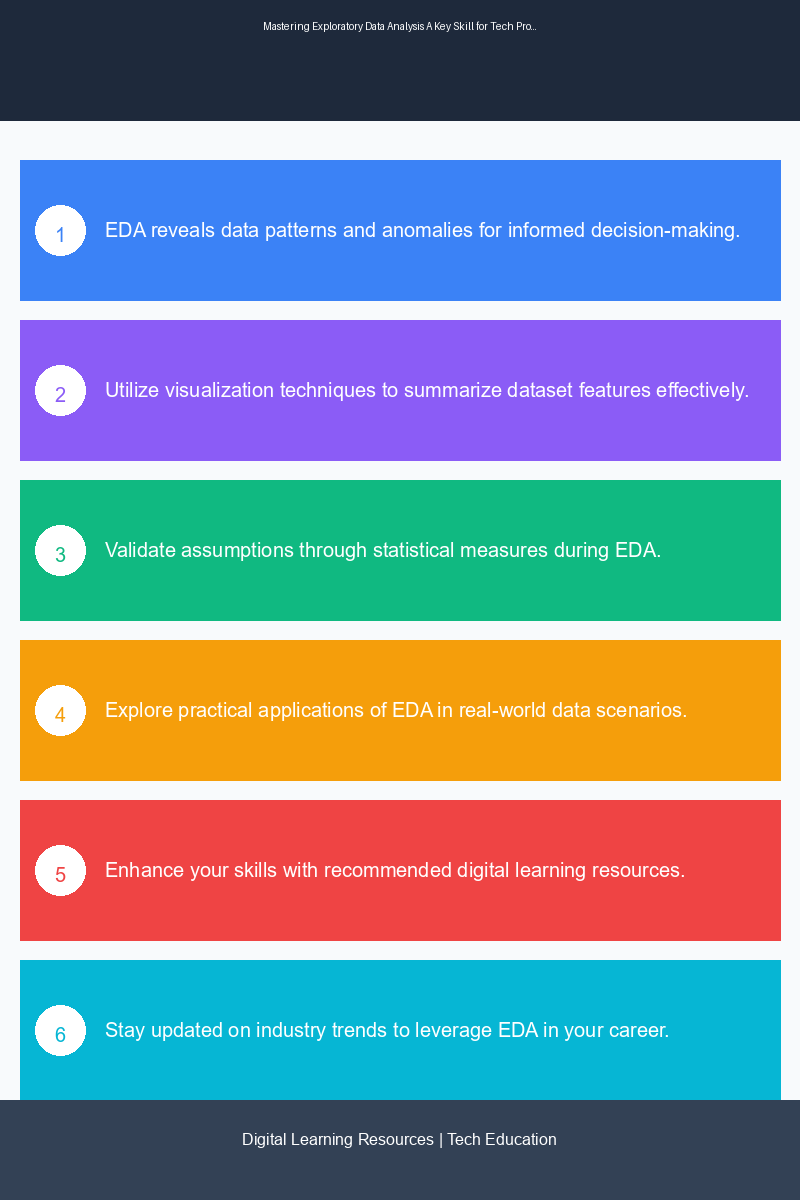Key Takeaways: Exploratory Data Analysis (EDA) is a crucial process for understanding data. By utilizing visualization techniques and statistical measures, professionals can uncover insights, validate assumptions, and make informed decisions. This blog post explores practical applications, learning paths, and industry trends that highlight the importance of EDA in today’s data-driven world.
Introduction
In the fast-evolving landscape of technology, the ability to analyze and interpret data sets is becoming increasingly essential for IT professionals, developers, and data scientists. Exploratory Data Analysis (EDA) stands out as a fundamental process in data analytics, offering a structured approach to uncovering the hidden stories within data. This blog post delves into the technical background and context of EDA, its practical applications, recommended learning paths, and insights into its industry impact and career implications.
Technical Background and Context
EDA is a data analytics process aimed at understanding the underlying characteristics of data before formal modeling or hypothesis testing. It employs various methods and techniques to summarize the main features of a dataset, often using visual methods. Here are some key components of EDA:
📚 Recommended Digital Learning Resources
Take your skills to the next level with these curated digital products:
AI Enhanced Resume Builder
AI Resume Builder Flask App – Complete Source Code + PDF Tutorial + HTML | Digital Download for Designers
Learn AWS: Your First Cloud Application
Learn AWS: Your First Cloud Application
📊 Key Learning Points Infographic

Visual summary of key concepts and actionable insights
Comprehensive SAT Prep: 470+ Vocabulary Words
Comprehensive SAT Prep: 470+ Vocabulary Words
Master DevOps in Practice – 50 Essential Topics for Engineers (PDF eBook)
Master DevOps in Practice – 50 Essential Topics for Engineers (PDF eBook)
The Ultimate Keyboard Shortcut Guide 49 Software Cheat Sheets in One PDF Bundle
The Ultimate Keyboard Shortcut Guide 49 Software Cheat Sheets in One PDF Bundle
- Visualization Techniques: EDA utilizes graphical representations such as bar charts, line charts, scatter plots, heatmaps, and box plots to visualize data distributions and relationships.
- Measures of Central Tendency: Understanding the dataset’s average (mean), middle (median), and most frequent (mode) values is crucial for summarizing data.
- Measures of Dispersion: Key metrics like range, variance, and standard deviation help assess the spread of data points.
- Statistical Tests: Techniques such as t-tests and chi-square tests are employed to validate assumptions about relationships within the data.
- Pattern Identification: EDA focuses on recognizing patterns, trends, and outliers, which can influence the direction of further analysis.
Practical Applications and Use Cases
Understanding EDA has significant practical applications across various domains. Here are a few use cases:
- Business Intelligence: Companies leverage EDA to analyze sales trends, customer behaviors, and product performance, enabling data-driven decision-making.
- Healthcare: EDA is used to identify trends in patient data, treatment outcomes, and disease spread, aiding public health decisions.
- Finance: Financial analysts utilize EDA to assess investment risks, market trends, and economic indicators.
- Marketing: Marketers apply EDA to segment audiences, measure campaign effectiveness, and identify potential customer needs.
These applications underscore the necessity for tech professionals to become proficient in EDA techniques and methodologies.
Learning Path Recommendations
For those looking to enhance their EDA skills, a structured learning path is crucial. Here’s a recommended progression:
- Familiarization with Data Sets: Begin by exploring publicly available datasets (like Kaggle or UCI Machine Learning Repository) and understanding the domain of interest.
- Data Collection Methods: Learn how to gather data from various sources, such as databases, web scraping, and APIs.
- Data Visualization Tools: Familiarize yourself with visualization tools, such as Tableau, Power BI, or Python libraries like Matplotlib and Seaborn.
- Statistical Analysis Skills: Gain proficiency in statistical concepts and techniques, including hypothesis testing and regression analysis.
- Iterative Analysis: Embrace the iterative nature of EDA by seeking feedback and refining your analyses based on insights gained.
Industry Impact and Career Implications
The significance of EDA in the data science process cannot be overstated. It serves as a critical foundation for interpreting complex datasets and making informed decisions. Tech professionals with strong EDA skills are highly sought after, as they can transform raw data into actionable insights.
Career opportunities in this domain include roles such as:
- Data Analyst
- Business Intelligence Analyst
- Data Scientist
- Market Research Analyst
Holding certifications in data analytics or specific tools related to EDA can further bolster your qualifications and make you a more attractive candidate in the job market.
Implementation Tips and Best Practices
To effectively implement EDA in your projects, consider the following best practices:
- Start with a Clear Objective: Define what you want to achieve with your analysis upfront to stay focused.
- Clean Your Data: Address data quality issues early on, such as missing values or erroneous entries, to ensure accurate analysis.
- Use Multiple Visualization Techniques: Different visualizations can reveal different insights, so don’t rely on a single method.
- Document Your Process: Keeping a record of your analysis steps helps in reproducing results and refining your approach.
- Collaborate with Others: Engaging with peers can provide fresh perspectives and insights that enhance your analysis.
Future Trends and Skill Requirements
As the field of data analytics continues to evolve, several trends are emerging that will shape the future of EDA:
- Increased Automation: Tools that automate EDA processes will become more prevalent, allowing analysts to focus on interpretation rather than execution.
- Real-time Data Analysis: The demand for real-time analysis will grow, especially in industries like finance and e-commerce.
- Integration with Machine Learning: EDA will increasingly be integrated with machine learning techniques to enhance predictive analytics capabilities.
To stay relevant, tech professionals should continuously update their skills and familiarize themselves with emerging tools and methodologies.
Conclusion with Actionable Next Steps
Mastering Exploratory Data Analysis is a vital skill for any tech professional looking to thrive in a data-driven world. By understanding its concepts, applying them in practical contexts, and following a structured learning path, you can enhance your analytical capabilities and career prospects.
Actionable Next Steps: Start exploring datasets today, familiarize yourself with data visualization tools, and consider pursuing relevant certifications. Engage with the data community to share insights and learn from others. Your journey in mastering EDA begins now!
Disclaimer: The information in this article has been gathered from various reputed sources in the public domain. While we strive for accuracy, readers are advised to verify information independently and consult with professionals for specific technical implementations.
Ready to advance your tech career? Explore our digital learning resources including programming guides, certification prep materials, and productivity tools designed by industry experts.



